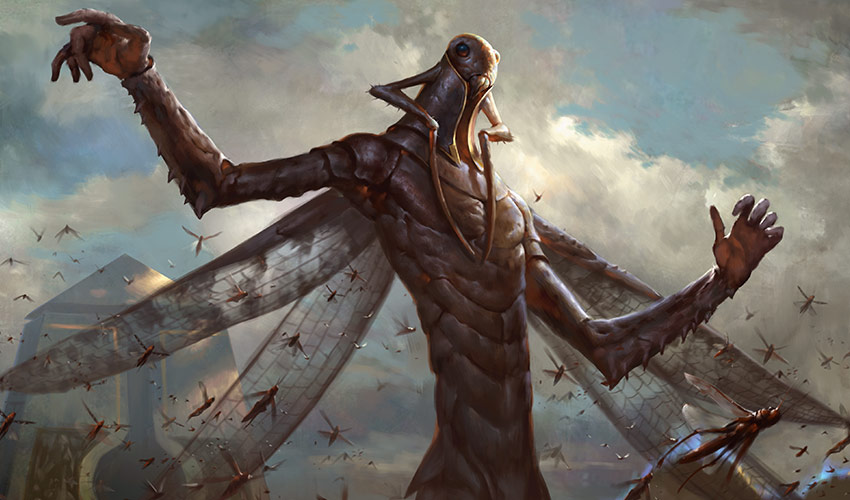Let's Talk about Rares
If you're a Magic player in tune to what's happening (which you probably are if you're reading this article!), there's a good chance you're headed down to your local Hour of Devastation Prerelease this weekend. (And if the word "Prerelease" doesn't mean anything to you, definitely check out my Prerelease primer here and use the store locator to find a Prerelease near you! My favorite kind of Magic event, there's nothing quite like a Prerelease.
Okay. So, you sit down. You get your awesome-looking sealed box. And, as soon as the store waves the proverbial flag (or actual flag—that sounds pretty cool, truthfully) to give the go-ahead, you'll crack that box open and begin to quickly dig your fingers into the packs within and free those cards from their foil cages.
And what's the first thing you're going to do upon opening each booster?
Well, if you're like many, many other Magic players, you're going to head to the back of the pack and look at your rare!

This is something we all start doing from the beginning of our booster-cracking experiences. We all want to know: "What is the awesome goodie I opened up?"
But this is different than just taking these cards and putting them into our favorite Standard deck. You are actually going to need to build a deck with these cards. And what happens if you open an awesome rare but it might be tricky to play it here?
Well, let's talk about that today.
Coloring Your View
When you watch Draft pundit, former Limited Resources host, and Wizards of the Coast internal Sealed League end-boss Ryan Spain open his Sealed pool, he sometimes does something quite different from most people.
Ryan opens his packs face down, intentionally takes his rares (still face down), and sets them in a pile off to the side.
He then begins sorting his colors and gauging which colors look the strongest. It's not until after he's begun to hone in on some colors that he flips his rares face-up and takes a gander at what options they present him with.
Why does Ryan do this?
Because rares are incredibly alluring . . . and, sometimes, dangerously so.
Let's say you open your first Hour of Devastation pack. And you see The Scorpion God sitting in that awesome rare slot.
Well, that's awesome! And look how powerful it is! Wow, wouldn't it be great to play with that card?
And, as you open the rest of your packs and sort your cards, in the back of your mind your brain is thinking about The Scorpion God. It wants you to play with it. Look how awesome it seems! And by the time you've finished opening your packs, you naturally are already leaning toward two specific colors.
Now, here's the problem: it might not be right to play either of those two colors. But because you started your experience by seeing through the (multi)colored lens of The Scorpion God, you try making it work and eschew your other colors earlier than you maybe should have—potentially hurting your deck in the process.
Ryan takes a different tactic here.

He wants to know what colors he leans toward without crazy bomb rares pushing him in one direction or another. And why is that?
Because, in Limited, a deck is far more than just one card. Well, first of all, you need at least 40 cards, and about 23 of them nonlands. But secondly, your deck needs to be something that overall works and has a game plan—not something you forced to work because you wanted to play with a specific rare.
I have seen many, many Sealed pools where people eschewed great commons and uncommons in one color for a strong rare and a bunch of mediocre cards in another color. Usually, that's the wrong call.
It's important to note that Ryan certainly still takes his rares into account. He doesn't just build his deck and then blindly flip his rares at the end, and when he sees he opened two Glorybringers (again Ryan, really?!) shrug and entirely ignore them. He tries to evaluate his pool independent from his rares first to let the primary bias he picks up (if he's going to have one) be relative color strength, and that's a much better gauge of power.
Your goal in Limited is usually to make your entire deck as strong as possible, not just to maximize having a couple spikes of power and ending up with a weaker deck on average.
"Usually"
So, why qualify that last point with "usually"? Well, like most things in Magic, there are exceptions.
You absolutely don't want your rares to push you away from rich, deep colors. If you're eschewing white when it has a ton of great removal and creatures because you opened up one awesome rare and a bunch of four-mana 3/3s in blue, that's going down the wrong path.
But what if you don't have colors that are that good?
Sealed Deck is an unusual format in that you're really at the mercy of what you open. In Constructed you bring your own deck and in Draft you can pick from the whole table, but in Sealed your six packs are what you're stuck with—for better or worse.
Sometimes you end up with great Sealed pools, and that's awesome. But a whole branch of Sealed deck-building theory is dedicated to the opposite: how do you win when your pool isn't that strong?
And that's where building toward your rares really can appropriately come into play.

Let's say you open your pool, and you've evaluated it. You think it's on the weak side. You could build a below-average two-color deck, which will be good enough to combat similarly below-average decks but will lose out to most people who opened stronger pools.
This means it's time to take a risk.
If you're playing in a big event, you're presumably looking to win, and to do so you're going to have to slice through other winners. One way you can beat decks better than yours is by maximizing your powerful rares and creating solitary spikes of power that can overcome opponents if left unchecked.
Let's say you open the aforementioned Glorybringer.
You think your overall best build is a white-blue deck. Most of your red cards are pretty poor. But you also think your deck is weak overall and doesn't have many individually strong cards.
Well, in this case, it may be worth swapping one of your colors in for red to pick up that Glorybringer. Even if it weakens your deck on average, if your deck is weak on average, then you may need the extra boost to help you win. (And in this specific example, I'd probably do things like play more cycling cards so you have a higher chance of finding it.)
Now, you have to be honest with yourself for this to work. If you tell yourself that your above-average deck is actually below average just so you can talk yourself into playing Glorybringer, then that kind of defeats the point. This isn't always right to do. But it's a tactic you can deploy in very specific instances.
Splashing Rares
One other important avenue to consider: you can always try to splash your rares.
Especially in Sealed, where the format is typically slower and you have more time to find your colors, splashing cards is reasonable. For example, if you opened a copy of The Scorpion God and were missing the black from your deck to play it, you could play a couple swamps and fit it in there.
Now, you shouldn't always do this; it definitely depends on the card and on your deck. But it's an option to keep in mind while building, especially if you opened good mana fixing.
Curious for more on this? I talked a lot about splashing in my article "Making a Splash." Look there for more recommendations on when (and when not to) splash cards.
Rare Advice
It took me many years to not start building my Sealed deck by looking at which rares I opened—so hopefully this gives you a head start to break that habit! May this article give you some added help and direction when building your deck at a Prerelease this weekend.
Have any questions or thoughts about this article or otherwise? I'd love to hear from you! You can always reach me on Twitter, Tumblr, or by sending me an e-mail (in English, please) at beyondbasicsmagic@gmail.com.
Have a fabulous Prerelease, and I'll talk with you again next week! Enjoy everything Hour of Devastation has to offer.

